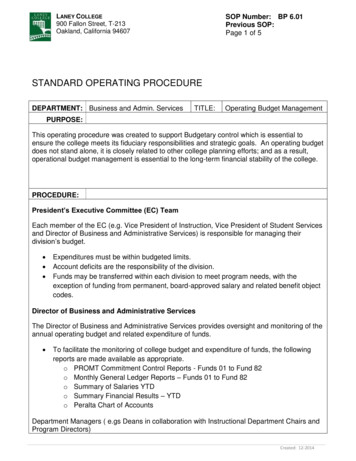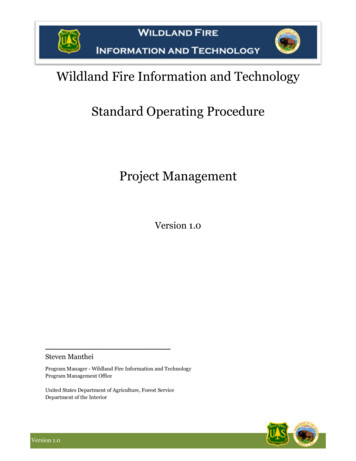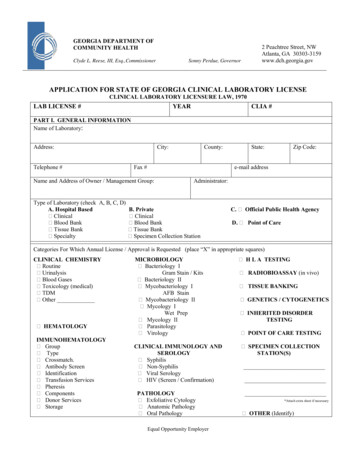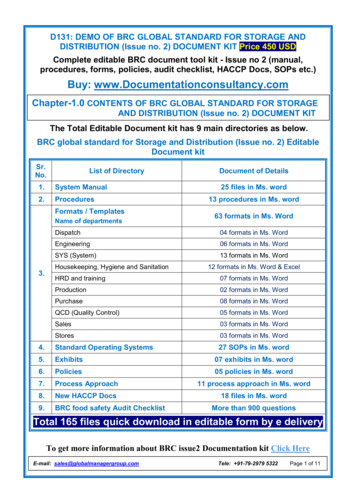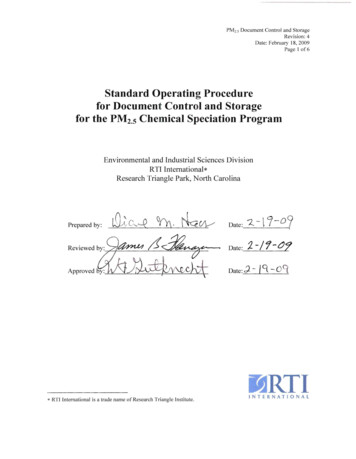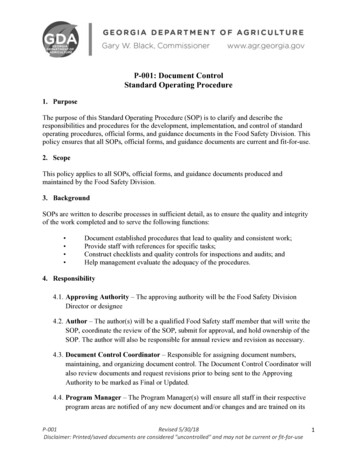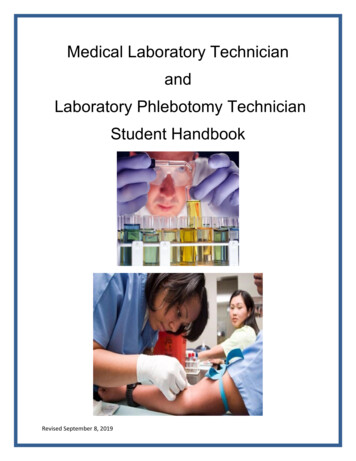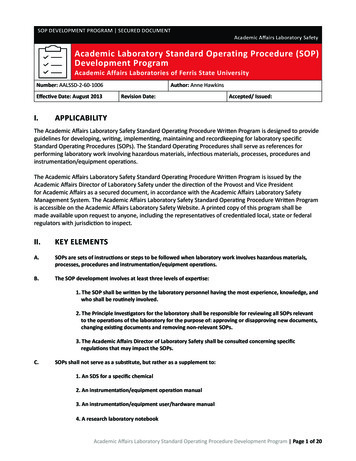
Transcription
SOP DEVELOPMENT PROGRAM SECURED DOCUMENTAcademic Affairs Laboratory SafetyAcademic Laboratory Standard Operating Procedure (SOP)Development ProgramAcademic Affairs Laboratories of Ferris State UniversityNumber: AALSSD-2-60-1006Effective Date: August 2013I.Author: Anne HawkinsRevision Date:Accepted/ Issued:APPLICABILITYThe Academic Affairs Laboratory Safety Standard Operating Procedure Written Program is designed to provideguidelines for developing, writing, implementing, maintaining and recordkeeping for laboratory specificStandard Operating Procedures (SOPs). The Standard Operating Procedures shall serve as references forperforming laboratory work involving hazardous materials, infectious materials, processes, procedures andinstrumentation/equipment operations.The Academic Affairs Laboratory Safety Standard Operating Procedure Written Program is issued by theAcademic Affairs Director of Laboratory Safety under the direction of the Provost and Vice Presidentfor Academic Affairs as a secured document, in accordance with the Academic Affairs Laboratory SafetyManagement System. The Academic Affairs Laboratory Safety Standard Operating Procedure Written Programis accessible on the Academic Affairs Laboratory Safety Website. A printed copy of this program shall bemade available upon request to anyone, including the representatives of credentialed local, state or federalregulators with jurisdiction to inspect.II.KEY ELEMENTSA.SOPs are sets of instructions or steps to be followed when laboratory work involves hazardous materials,processes, procedures and instrumentation/equipment operations.B.The SOP development involves at least three levels of expertise:1. The SOP shall be written by the laboratory personnel having the most experience, knowledge, andwho shall be routinely involved.2. The Principle Investigators for the laboratory shall be responsible for reviewing all SOPs relevantto the operations of the laboratory for the purpose of: approving or disapproving new documents,changing existing documents and removing non-relevant SOPs.3. The Academic Affairs Director of Laboratory Safety shall be consulted concerning specificregulations that may impact the SOPs.C.SOPs shall not serve as a substitute, but rather as a supplement to:1. An SDS for a specific chemical2. An instrumentation/equipment operation manual3. An instrumentation/equipment user/hardware manual4. A research laboratory notebookAcademic Affairs Laboratory Standard Operating Procedure Development Program Page 1 of 20
III.ROLES IN THE PROCESS A.Responsibilities and Authority of the College Dean1. Support Academic Affairs Laboratory Safety Management System compliance in meeting federal, stateand local regulating requirements within any remodeled, renovated, existing or new laboratoryfacilities.2. Receive notification from the Department Chair/Director/Head, Faculty or Staff in the event of anincident.3. Notify the Academic Affairs Director of Laboratory Safety of any incident as soon as they becomeaware of the situation.4. Request assistance from the Academic Affairs Director of Laboratory Safety when conditions changewithin any Academic Affairs laboratories that may impact the operations of that laboratory to:a. Conduct a Hazard Assessmentb. Identify the appropriate engineering controls, personal protective equipment, and workpractices.5. Oversee compliance training requirements for Faculty, Staff and Student Employees that have beenestablished for any Academic Affairs laboratory area.B.Responsibilities and Authority of Department Chairs/Directors/Heads1. Support Academic Affairs Laboratory Safety Management System compliance in meeting federal, stateand local regulating requirements within a laboratory facility.2. Notify the Dean’s office if the Department Chair/Director/Head receive notification from the Facultyor Staff of an incident.3. Ensure all training requirements for Faculty, Staff and Student Employees who have been authorizedto use or work in any Academic Affairs laboratory area have been complied.4. Support completion, in a timely manner, of all written laboratory SOPs addressing laboratory workthat involves hazardous materials, processes, procedures and instrumentation/equipment.5. Support SOP training and recordkeeping compliance requirements for Faculty, Staff and StudentEmployees who have laboratory responsibilities.C.Responsibilities and Authority of Faculty and Staff Who Provide Oversight for the Laboratory1. Conduct and document hazard assessments:a. Prior to acquiring gifted, loaned, rented or purchased instrumentation/equipment.b. On laboratory start-up or scale-up materials, processes, procedures and instrumentation/equipment.c. When there are changes to the materials, processes, procedures and instrumentation/equipment involved.Academic Affairs Laboratory Standard Operating Procedure Development Program Page 2 of 20
2. Oversee the SOPs’ development by laboratory personnel having the most experience and knowledge,and who may routinely be involved in the experimental or operational processes.a. Ensure that developers of the SOPs includes the step-by-step detailed usage and handlingrecommendations provided by the material/chemical manufacturer.b. Ensure that developers of the SOPs include the step-by-step detailed usage and handlingrecommendations provided by the instrumentation/equipment manufacturer.c. Ensure that developers of the SOPs include all the material handling, disposal, personalprotective equipment, and engineering controls (such as hoods) requirements that directlysupports the steps in the SOP.d. Encourage the usage of pictures within the SOPs, such as in the case of operatinginstrumentation/equipment, to add clarity to the proper operations.e. Ensure that developers of the SOPs include any references used to develop the SOP in thereference section of the SOP.3. Shall sign all step-by-step detailed SOPs, acknowledging that the contents, requirements, andresponsibilities outlined in the SOPs are correct based on the hazard assessments.a. SOPs which are signed by the Principal Investigators, Faculty Laboratory Instructors and/orLaboratory Supervisors shall be considered to have been reviewed by qualified personneland are considered an official SOP for the laboratory. The new or revised SOP documentationmay be implemented after the laboratory personnel who will be performing the SOP havebeen trained. This training shall be documented in writing and filed in the training filesassociated with the Principle Investigator, Faculty Laboratory Instructor or LaboratorySupervisor.b. SOPs that are not signed by the Principal Investigators, Faculty Laboratory Instructors and/or Laboratory Supervisors are not considered to have been reviewed by a qualifiedpersonnel, and are not official SOP for the laboratory. They may be implemented only underdirect Principal Investigators’, Faculty Laboratory Instructors’ or Laboratory Supervisors’supervision.c. When an SOP is no longer required to support hazardous materials, processes, proceduresor instrumentation/equipment, they shall be removed from service by the PrincipalInvestigators, Faculty Laboratory Instructors and/or Laboratory Supervisors. The removalprocess shall follow these steps:1. On the first page of the SOP, designate it as “No Longer Applicable” with the date ofthis action and the signature of the Principal Investigator, Faculty LaboratoryInstructor and/or Laboratory Supervisor.2. The SOP shall be removed from the active SOPs and placed in the designated “NonActive SOPs” file.4. Shall identify a location for all SOPs within the laboratory:a. This location shall be signed and easy to access by anyone within the laboratoryb. It shall contain both active and non-active SOPs5. Shall review all SOPs on a yearly basis:Academic Affairs Laboratory Standard Operating Procedure Development Program Page 3 of 20
a. This review shall be documented on the last page of the SOP with the Principal Investigator’s,Faculty Laboratory Instructor’s or Laboratory Supervisor’s signature and date.b. If this annual review identifies changes to the SOP; this information shall be denoted on thelast page of the SOP.1. All laboratory personnel shall be trained on the changes and their trainingdocumented.2. If the SOP requires a re-write, it shall go through the approval process. Alllaboratory personnel shall be trained on the revised SOP and their trainingdocumented.C.Responsibilities and Authority of Laboratory Personnel1. Under the direction of the Faculty or Staff who provide oversight for the laboratory, the LaboratoryPersonnel will assist with:a. Conducting and documenting hazard assessmentsb. Developing the step-by-step SOP detailing:1. The use of hazardous materials2. Processes and procedures specific to the laboratory in which they work3. Instrumentation/equipment operations as they relate directly to the laboratory2. Obtain the training necessary to:a. Perform processes and procedures within the laboratory which they are assigned.b. Operate the instrumentation/equipment within the laboratory which they are assigned.c. Maintain compliance with applicable environmental, health and safety federal, state andlocal regulations.3. Understand the use of SOPs, their locations, and the method used to conduct their annual review.4. Comply with the SOPs recordkeeping requirements.D.Responsibilities and Authority of the Academic Affairs Director of Laboratory Safety1. Shall develop, maintain and revise this written program as needed;a. As a secured document to ensure compliance with applicable regulations.b. Evaluate the overall effectiveness of this program on a periodic basis, and revise the programas needed to effectively establish and maintain a safe workplace environment, and to ensurecompliance with federal, state and local occupational health and safety and/orenvironmental regulations and standards.Academic Affairs Laboratory Standard Operating Procedure Development Program Page 4 of 20
IV.PROCESSA.Type of SOPs1. Based on the Hazard Assessment (template located in Appendix A) SOPs may be divided into threetypes:a. Material Hazards (such as but not limited to biological, chemical and radiationhazards)b. Process Hazards (describes the process hazards and may include chemical, biological andradiation hazards if they are a part of the process)c. Instrumentation/equipment usage (describes how to use, in simple step-by step processes)2. Material Hazard SOPs shall be written based on the individual hazard material, or with somechemicals by chemical family, as long as the hazards of the grouping do not cloud the user’sunderstanding of the hazards associated with each member of a chemical manufacturer.3. Process Hazard SOPs shall be written based on the evaluation of the hazards presented by thematerials in use, and an evaluation of the processes or procedures.a. Review the type and quantity of the hazardous materials being used, along with thefrequency of useb. Evaluate the processes and experimental design, work space adequacy, laboratory personnelpreparedness and qualifications4. SOPs for Particularly Hazardous Substances shall include a description of a designated area,containment devices, decontamination and waste disposal procedures.5. Instrumentation/equipment SOPs shall include the very basic step-by-step processes needed toperform the daily operations of the instrumentation/equipment. This type of SOP is intended tosupplement the owner’s operation manual.Chemical HazardsProcess HazardsChemical SpecificExperimental DescriptionChemical FamilyProcess DescriptionHazard AssessmentSOPAcademic Affairs Laboratory Standard Operating Procedure Development Program Page 5 of 20
B.Conduct Hazard Assessment1. The Principal Investigators, Faculty Laboratory Instructors or Laboratory Supervisors shall conduct ananalysis of possible laboratory based hazards using the assessment tool in Appendix A.2. This assessment shall occur:a. Whenever possible, while the processes, procedures or instrumentation/equipment are inuse.b. Record the potential hazards.c. Identify the engineering, administration and personal protective equipment controls that willmitigate the hazards identified.3. After determining both the material hazards and the processes, procedures and instrumentation/equipment hazards, the Principal Investigators, Faculty Laboratory Instructors or LaboratorySupervisors shall determine the level of controls needed to allow for the reasonable safety of thelaboratory personnel performing the described processes, procedures or instrumentation/equipment.a. When requested, the Academic Affairs Director of Laboratory Safety shall assist the PrincipalInvestigators, Faculty Laboratory Instructors or Laboratory Supervisors.b. When changes occur to either the materials involved, the processes, procedures orinstrumentation/equipment following the initial hazard assessment, these changes may alterthe level of control originally identified and included in the SOP. A new hazard assessmentwill be required.C.SOP DevelopmentThe laboratory personnel who are most familiar with the materials, processes, procedures or instrumentation/equipment,and who may routinely be performing the processes, procedures or using the instrumentation/equipment, shall write theSOPs.1. Using the SOP template in Appendix B, the writer, along with the completed Hazard Assessmentand, in the case of instrumentation/equipment, the owner’s operationmanual along with their working knowledge, write the step-by-step SOPs.2. Section One of the SOP requires the following information:a. Identify the type of SOP (Material Hazard, Processes, Instrumentation/Equipment)b. The names of the individuals involved with the preparation of the SOPc. The date developed, which is the final draft dated. The date of approval will be the date the Approver signs the document and authorizes itsimplementation by qualified, trained and approved laboratory personnel without the directsupervision of the Principal Investigators, Faculty Laboratory Instructors and LaboratorySupervisorse. Approval of an SOP may only occur by a Ferris State University Approver. This individual willsign the SOP and provide the date the document was signed in the Date Approved section3. Section Two of the SOP, the Purpose and Scope Section, identifies:a. The specific materials, processes, experiments or instrumentation/equipmentinvolvedAcademic Affairs Laboratory Standard Operating Procedure Development Program Page 6 of 20
b. The laboratory personnel involved and the necessary skill level needed to perform the SOPc. The location where the materials and instrumentation/equipment will be used and thelocation where the processes and experiments will be performed4. Section Three of the SOP, the Hazards and Control Section, identifies:a. The materials, processes, procedures or instrumentation/equipment hazards associated withthis task which may present exposure hazards, health hazards or physical hazards.b. Any potential exposures that may be encountered when using the instrumentation/equipment, such as aerosol generation during missing centrifuging or sonication, whenhazardous conditions occur such as extreme temperatures.c. Any technique hazards such as weighing air reactive solidsd. Any special handling and storage requirements needed to work with the material, process orinstrumentation/equipment5. Section Four of the SOP, the Engineering Control Section, identifies the equipment that shall be usedwhen carrying out the procedure, such as but not limited to chemical fume hood, biosafety cabinetand vacuum.6. Section Five of the SOP, the Personal Protective Equipment Section, identifies the specific PPErequirements for the tasks and the specific hygiene practices to be performed with each process,instrumentation/equipment usage, or hazardous chemical.7. Section Six of the SOP, Procedure Section, identifies the step-by-step information for preforming thematerial, process, procedure and instrumentation/equipment operations.a. Material SOP – describes how to work with the specific material and it identifies:1. The hazards associated with this specific material2. How to transfer the material3. Incompatibilities with other materials or agents that should be considered whenplanning a process or procedure4. Transferring to a waste container and vessel compatibilityb. Process SOP -- describes in detail the procedure used to perform the process, procedure orinstrumentation/equipment;1. The use of pictures are encouraged to enhance the end user’s understanding.2. Include any procedure that shall be followed to start or end a process or procedure,including any specific steps that shall be followed once the process or procedure iscomplete.c. Instrumentation/Equipment SOP -- describes the step-by-step procedure for using theinstrumentation/equipment;1. This type of SOP is not intended to take the place of the owner/operator manual.2. The use of pictures are encouraged to show operational settings and emergencypower down steps.Academic Affairs Laboratory Standard Operating Procedure Development Program Page 7 of 20
8. Section Seven of the SOP, the Waste Disposal Section, identifies the step-by-step process for handlinghazardous waste.a. This section will identify what materials are hazardous, non-hazardous or biohazardouswasteb. If materials can be combined into a single waste container, the handling procedure for thecollection, storage and disposal will be written out step-by-stepc. If materials cannot be combined into a single waste container, special handling requirementswill be written out step-by-stepd. The type of compatible containers will be identified for each type of waste generatede. The labeling requirements and segregation prior to disposal9. Section Eight of the SOP, the Emergency Response Section, identifies specific steps directly related tothe material, process, procedure and instrumentation/equipment to take in the event of anemergency.10. Section Nine of the SOP, the Training/Recordkeeping/Definition Section, contains the followinginformation:a. Definitions of all terms and regulatory acronyms if applicableb. Training requirements—what training the laboratory personnel shall have successfullycompleted prior to having authorization to perform the SOPc. Determination if the SOP is of such a hazardous nature that the Principal Investigators,Faculty Laboratory Instructors or Laboratory Supervisors will be required to grant in writingauthorization for the laboratory personnel to perform the SOPd. Recordkeeping requirements which identifies the requirements and the purpose of keepingthe recordse. Change control to the SOP, what changes may be made, and requires the approval ofPrincipal Investigator, Faculty Laboratory Instructors or Laboratory Supervisorsf. The history of the changes made to the documentg. Appendix which contains any appendix that supports the SOP such as but not limited to:1. Work flow diagrams2. Work Instructions3. Checklist4. FormsAcademic Affairs Laboratory Standard Operating Procedure Development Program Page 8 of 20
V.DEFINITIONSThe following is a list of common terms and their definitions as they are used in the Academic Laboratory StandardOperating Procedure Development Program.ApproverAn individual who is employed by Ferris State University as a Principal Investigator, Faculty Laboratory Instructors orLaboratory Supervisor, responsible for the laboratory or laboratory process, experiment or instrumentation/equipmentthat is addressed in the written SOP.Chemical FamilyIf chemical family SOPs are used, the families must be defined to ensure all the chemicals making up the family havesimilar physical and health hazards, common signs and symptoms of exposure intended processes/handling andanticipated laboratory personnel exposure. The SDSs associated with the chemicals in the chemical family shall bereferenced when developing the SOP. The final SOP for a chemical family shall provide appropriate guidance to ensurelaboratory personnel have the knowledge of the specific hazards, personal protective equipment, handling, storage anddisposal.EmployeeAn employee contributes labor and expertise to an endeavor of an employer (Ferris State University), and is usually hiredto perform specific duties that are packaged into a job. The term “employee” refers to a specific defined relationshipbetween an individual and the University.FacultyThe term is most commonly used in this context in the United States, includes professors of various rank: assistantprofessors, associate professors and full professors, usually tenured (or tenure-track) in terms of their contract ofemployment, as well as adjunct and instructors. Department chairs, Deans, vice presidents, presidents and librarians forthis document will be considered faculty members.Laboratory Start-upThe starting of the laboratory, changes in research or new research direction/grants.MaterialChemical, biological or radiation.Laboratory PersonnelFaculty, Staff, Student Employees and Students who perform duties within the laboratory.ProcedureMay refer to a routine event or an experiment which occurs in the laboratory that is documented by means of an SOP.StudentA learner, or someone who attends an educational institution.Student EmployeeIs a part-time employee who is duly enrolled at Ferris State University, is registered for classes and whose primary purposefor being at the University is the achievement of a degree or certification.Standard Operating Procedure (SOPs)A written set of steps to be followed by “laboratory personnel.” This document details an operation in terms of the stepsto be taken by the laboratory personnel in the order in which they should be accomplished. The SOP provides detailedwritten instructions to achieve uniformity of the performance of a specific function.Work Practice ControlsControls that reduce the likelihood of material release by altering the manner in which a task is performed.WriterIndividual or individuals who, based on their knowledge and work experience, have been requested by the PrincipalInvestigators, Faculty Laboratory Instructors or Laboratory Supervisors to used the hazard assessment and their workingknowledge to document in a step-by step form how to use hazardous materials, perform a process or experiment, andhow to use instrumentation/equipment.Academic Affairs Laboratory Standard Operating Procedure Development Program Page 9 of 20
VI.RELATED OR REFERRED TO DOCUMENTSAppendices-Appendix A: Laboratory Comprehensive Hazard Assessment and Controls Form - AALSSD-2-60-1006-F01-Appendix B: Standard Operating Procedures Template - AALSSD-2-60-1006-FF01Academic Affairs Laboratory Standard Operating Procedure Development Program Page 10 of 20
Appendix AAALSSD-2-60-1006-F01Laboratory Comprehensive Hazard Assessment and Controls FormLaboratory, Work Site, Project:Department/College:Completed by (print name and title):Principle Investigator (print name):Department Head (print name):Instructions:Review the Hazard Description (column 3) for each Exposure Condition (column 2) and check the ones that are present(column 1). For every condition present, review the Examples of Engineering Controls and Personal Protective Equipment(column 4) and then complete the Specific Engineering Controls and PPE (column 5) that you intend to use to reduce oreliminate the hazard.Check ifPresent(column 1)ExposureCondition(column 2)Hazard Description(column 3)Examples of Engineering andPersonal Protective Equipment(PPE)(column 4)Specific EngineeringControls and PersonalProtective Equipment (PPE)(column 5)Biological HazardsAnimalsSplashes, bites,exposure to animalbody fluids, injuriesdue to animal size orcaging, allergies, anddisease transmissionRequires approval by IACUCCarcinorgensCancerPosted work areas, glove box,fume hood, special handling,and glovesMore on BSLlevelHuman Blood orOther PotentiallyInfectiousMaterialsSee Academic Affairs Directorof Laboratory SafetyDisease transmissionToxinsMay require IRB approval;Blood-borne Pathogen training,and Universal PrecautionsSee Academic Affairs Directorof Laboratory SafetyInfectiousPathogensDisease transmissionGood microbiological methods,engineering controls, glovesNano-particlesUnknown healthhazards due to smallsizeContainment;See Academic Affairs Directorof Laboratory Safety.Academic Affairs Laboratory Standard Operating Procedure Development Program Page 11 of 20
Check ifPresent(column 1)ExposureCondition(column 2)RecombinantDNAHazard Description(column 3)Examples of Engineering andPersonal Protective Equipment(PPE)(column 4)Depends on natureof DNA segments,host vector systems;Introduction of foreigngenetic materialsinto personnel orenvironmentRequires IBC Approval; Goodmicrobiological methods,engineering controls andpersonal protective equipmentChemicals, lowhazard withlow splashprobabilitySkin and eye irritationSafety glasses, chemicalresistant gloves, lab coat,closed toe shoes of goodstructure, long pants; Be awareof the nearest eyewash andshowerCompressedgasesAphyxiation,accidental tip over,content release, andpinch pointsGas cylinders must be securedto stationary objects in a safelocation away from dangeror impact; Safety glasses andglovesControlledSubstancesDrugs and certainother chemicals(narcotic and nonnarcotic)Proper training, handlingand dispensing procedures,recordkeeping, safety glasses;Under the jurisdiction offederal and state lawsCorrosive liquidsw/reasonableprobability ofsplashSkin and eye damageChemical splash goggles orface shield, neoprene gloves,lab coat, closed toe shoes, andchemical resistant apronSpecific EngineeringControls and PersonalProtective Equipment (PPE)(column 5)Chemical HazardsCryogenicAphyxiation, skin, eyeliquids, ultra-cold and tissue damage,freezers, dry icefrostbiteVentilation, safety glasses,goggles or face shields forsplash hazards, insulatedgloves, and closed toe shoesOrganic solventsSkin/eye damage,absorption throughskin, organ damageChemical splash gogglesor a face shield with safetyglasses, heavy resistant gloves,lab coat, closed toe shoes,chemical resistant apron,eyewash and showerVolatile,hazardous orhighly hazardouschemicalsInhalation of toxicvapors, skin contactFume hood, glove box,safety glasses, and personalprotective equipmentRegulatedWastesExposure,environmental releaseSafety glasses, gloves,proper storage and disposalprocedures, training and safehandling proceduresAcademic Affairs Laboratory Standard Operating Procedure Development Program Page 12 of 20
Check ifPresent(column 1)ExposureCondition(column 2)Hazard Description(column 3)Examples of Engineering andPersonal Protective Equipment(PPE)(column 4)Special cleaningagentsExposure, allergiesToxic SubstancesPoisons, neurotoxins, Proper training procedures,teratogens, mutagens, storage, disposal, and personalcarcinogens,protective equipmentand subsequentenvironmental impact.WashingglasswareSkin lacerations frombroken glassChemicalSpecific EngineeringControls and PersonalProtective Equipment (PPE)(column 5)Safety Data Sheets, hazardcommunication training,proper procedures, andpersonal protective equipmentSafety glasses, rubber gloves,lab coat.See Academic AffairsDirector of Laboratory Safetyconcerning chemical specificengineering and personalprotective equipmentRadiological HazardsIonizingRadiationCancer, teratogenicApproved by Radiation SafetyOfficerNon-IonizingRadiationEye or skin damage,burns, heat, cancerApproval by Radiation SafetyOfficerPhysical HazardsCompression(pressure)Injury from suddenEnergy control, safety glasses,release of energy from shields, body positionvalves, compressionchambersConfined SpacesExposure, falls,dangerousatmospheres,asphyxiation, noise,vibrationBuddy system, lanyards,ventilation, monitoringElevated heightsFall injuryLanyards, anchorsEnergizedEquipmentPinched, crushed,caught, pulled in,electrocutionEnergy control, signage,guards, no jewelry, tie backlong hairExtremeEnvironmentalConditionsHypothermia (cold),frostbite (cold), heatexhaustion (heat) orheat stroke (heat)Training, physiologicalmonitoring, rest cycles andfluid replacementImpactInjury to head or bodyHard hat, impact resistant toedshoes, body positionManipulation oflarge objectsInjury, deathTraining, proper liftingequipment, procedures,inspections, buddy systemsMaterialHandlingPhysical injury, strains, Training, buddy system, gloves,sprainsStandard Operating ProceduresAcademic Affairs Laboratory Standard Operating Procedure Development Program Page 13 of 20
Check ifPresent(column 1)ExposureCondition(column 2)Hazard Description(column 3)Examples of Engineering andPersonal Protective Equipment(PPE)(column 4)NoiseDeafness, hearingdamage, inability tocommunicateNoise monitoring, hearingprotection, training, andengineering controls (e.g.,enclosures, baffles, mufflers)PenetrationInjection, woundsTraining, padding of surfaces,signage, and body positionRespirable DustLung damageLocal exhaust ventilation.monitoring, respiratorVibratingEquipmentCumulative traumadisorders.Gloves, protective shoes,hearing protectionAnimalExposure, bites,animals are missingor have been misstreatedTraining, Documentation ofAnimals wellbeing, log ofAnimals, Control accessBiologicalExposure, eyes, skin,Training procedures, cleaninhalation, absorption, up spill kit available, medicalinjectionfollow-upChemicalExposure, eyes, skin,inhalation, absorption,injection, fire,explosionTraining procedures, cleanup spill kit available, medicalfollow-up, first respondersinformation provided to localauthoritiesRadiationExposure, eyes, skin,inhalation, absorption,injection, fire,explosionTraining procedures, cleanup spill kit available, medicalfollow-up, first respondersinformation provided to quipment fails tooperate as designedTraining, out of service,work orders, manufacturepreventative maintenanceperformed, valid servicea
The Academic Affairs Laboratory Safety Standard Operating Procedure Written Program is issued by the Academic Affairs Director of Laboratory Safety under the direction of the Provost and Vice President for Academic Affairs as a secured document, in accordance with the Academic Affairs Laboratory Safety Management System.
